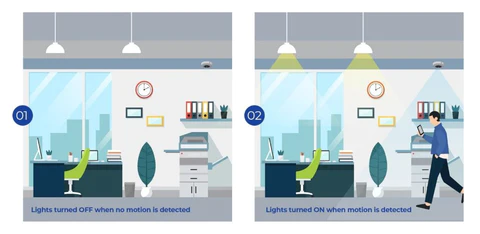Smart Sensors_ Applications, Benefits, and Working

It is the dawn of a sensor-driven smart era!
Sensors observe, report, and respond to the happenings around. They play a significant role in making human life easy and better. Sensors can adjust lights as per mood and need, ON/OFF a range of devices including water heaters, security cameras, tracking devices, and more. These sensors also provide detailed information on workflows, work patterns, and environmental conditions. They can also monitor and control devices, thereby improving the operational efficiency of enterprise management.
As the Internet of Things (IoT) advances, impacting and influencing human life, the use of smart sensors is also growing steadily. It has reached a point where the intelligent sensors constitute an integral part of an IoT system and define its existence.
How do the sensors function?
Sensors capture data and convert them into measurable electrical signals. These data, otherwise physical properties, are the details of mass, speed, temperature, pressures, and presence of heat bodies. The microprocessor will then process the electrical signals and act accordingly. Finally, the system triggers the receiver to function desirably.
A system will have multiple sensors with different functions and capabilities depending on its functional complexities and demands. For the desired output, there will be more receivers, power sources, and transmitters.
What are the different types of Sensors?
There are different sensors like motion sensors, light sensors, thermal sensors, wind sensors, time sensors, location sensors, sound sensors, matter sensors, and smoke sensors. These sensors are classified based on their features and capabilities to measure data or physical properties.
Now, let us delve into the details of smart sensors
Motion Sensors
Motion sensors are designed to detect human presence. When a person enters or leaves a space, the sensor detects motion and sends signals to initiate process. The power supply to the light fixture will be increased or decreased. Accordingly, motion sensors automate the device’s functions based on the occupancy or vacancy status. These sensors significantly reduce energy consumption, especially in industrial applications with larger areas and occupants.

Motion sensors are of different types, and the most commonly used ones are Passive Infrared (PIR) sensors and Microwave sensors.
A passive infrared sensor (PIR sensor) is an electronic sensor that detects the infrared radiation from a human body and triggers the control system to act accordingly. A microwave sensor uses microwave sensing technology to detect motion in a given space. The sensor sends microwave signals continuously, and when a person enters, the signal gets interrupted, triggering the control system to turn ON/OFF lights.
Light Sensors
Light sensors detect and react to different light levels of the season or day. These sensors automate device functioning, ensure energy saving, efficiency, and ambiance of space through daylight harvesting, human-centric lighting, and light schedule.

Thermal sensors
Thermal sensors are used to automate the room temperature of smart buildings and offices. These sensors maintain a consistent internal temperature irrespective of external temperature variation, helping in energy savings.
Wind Sensors
Smart buildings should be elegant, and the sensors should respond intelligently. When strong winds are detected, these sensors automate the smart shutdown of shutters, awnings, and dust skirts.
Smoke Sensors
Smoke sensors are electronic fire-protection devices that automatically detect the presence of smoke and trigger alarms. These sensors can be used to ensure the safety of individuals and buildings.
Smart Sensors for Industrial Applications
The demand for smart sensors is relentless in various industrial applications. The sensors can be used in the home or industrial settings like electronics, hospitality, medical, military, and more.
Healthcare:
In the health care setting, sensors can be used for various requirements, especially where automation is needed. It includes,
- Monitoring hand hygiene compliance
- Occupancy monitoring
- Automate temperature
- Human-centric lighting
- Smoke Sensors
Warehouse and Manufacturing:
Smart sensors help enterprises to enhance employee wellbeing, save energy, and result in better workflows. The sensors are capable of providing information like,
- Historical data for decision making
- Alerts and reminders on maintenance and repairs
- Lighting automation to ensure active environments
- Improved space utilization
Check to know how a California based leading environmental and industrial machinery manufacturer retrofitted their in-house system to a smart facility.
Hospitality
Sensors designed for restaurants and hotels help to reduce energy consumption and enhance the guest experience. Thermostats and occupancy sensors play a crucial role in the automation of temperature, light settings, and energy savings. The benefits include
- Automated guest interactions
- Guest Information
- Personalized experience
- Self-check-in/check-out and automatic room entry
- Push-notifications for room service
Offices
Smart-sensors in offices has immense benefits. They are;
- Reduce energy wastage
- Human-centricity
- Collect and analyze data in real-time
- Increase productivity and wellbeing
- Indoor wayfinding and smart-navigation
Home Automation
Sensors are the backbone of home automation, and they can be used for almost every requirement. These sensors can be used in a wide range of devices, ensuring intelligent security and energy savings.
- Automated device activation
- Mood lighting and temperature controls
- Pre-set routine schedules
- Theft and unauthorized access detection
The sensor-applications list still goes on. There is much more to explain than mentioned in the blog. To know more about smart sensors, Reach us !
Disclaimer: The original version of the blog was published in WiSilica.com